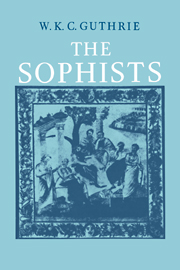Book contents
- Frontmatter
- Contents
- List of Abbreviations
- Preface
- I INTRODUCTION
- II TOPICS OF THE DAY
- III WHAT IS A SOPHIST?
- IV THE ‘NOMOS’ – ‘PHYSIS’ ANTITHESIS IN MORALS AND POLITICS
- V THE SOCIAL COMPACT
- VI EQUALITY
- VII THE RELATIVITY OF VALUES AND ITS EFFECTS ON ETHICAL THEORY
- VIII RHETORIC AND PHILOSOPHY (Seeming and being, believing and knowing, persuading and proving)
- IX RATIONALIST THEORIES OF RELIGION: AGNOSTICISM AND ATHEISM
- X CAN VIRTUE BE TAUGHT?
- XI THE MEN
- Bibliography
- Index of passages quoted or referred to
- General Index
- Index of selected Greek words
VIII - RHETORIC AND PHILOSOPHY (Seeming and being, believing and knowing, persuading and proving)
Published online by Cambridge University Press: 05 August 2015
- Frontmatter
- Contents
- List of Abbreviations
- Preface
- I INTRODUCTION
- II TOPICS OF THE DAY
- III WHAT IS A SOPHIST?
- IV THE ‘NOMOS’ – ‘PHYSIS’ ANTITHESIS IN MORALS AND POLITICS
- V THE SOCIAL COMPACT
- VI EQUALITY
- VII THE RELATIVITY OF VALUES AND ITS EFFECTS ON ETHICAL THEORY
- VIII RHETORIC AND PHILOSOPHY (Seeming and being, believing and knowing, persuading and proving)
- IX RATIONALIST THEORIES OF RELIGION: AGNOSTICISM AND ATHEISM
- X CAN VIRTUE BE TAUGHT?
- XI THE MEN
- Bibliography
- Index of passages quoted or referred to
- General Index
- Index of selected Greek words
Summary
(Seeming and being, believing and knowing, persuading and proving)
GENERAL
Rhetoric has already been mentioned in these pages (20, 50 f.), but demands a closer look. Obviously we are not here concerned with appraisal of the works of Lysias, Andocides or other Attic orators, nor with questions of manner and style; but the theory behind Greek rhetoric had philosophical implications, with which not only the Sophists but Plato himself felt that they had to come to grips. Plato could even describe his own dialectical philosophy as the substitution of good rhetoric for bad, and it has been contended that rhetoric alone was the distinguishing mark of a Sophist. That this is an exaggeration will have already appeared, but all the leading Sophists were deeply concerned with it, in its forensic, political and epideictic branches, both as active practitioners and as teachers, systematizers and writers of rhetorical handbooks. Plato, who knew his Sophists, distinguishes sophistic and rhetoric by an elaborate analogy, designed to show how ‘though they differ in nature, yet they are so closely related that Sophists and orators, working in the same sphere and on the same subject-matter, are confused, and know not what to make of themselves, nor others of them’. It must be read in the light of his own doctrine of the superiority of knowledge, reality and teaching to belief, appearance and persuasion. As gymnastic keeps the body fit, so legislation keeps a state sound and healthy. If the body falls sick, medicine will cure it, and the corresponding art in the state is the execution of justice. All these arts have their counterfeits. To gymnastic corresponds make-up, giving the appearance of health, and to legislation sophistic, claiming to impart what keeps a state sound, but without real knowledge. The counterfeit of the doctor is the chef, who claims to know the best diet for the body but in fact aims only at pleasing the palate, and similarly rhetoric corresponds to the due execution of justice in that it aims at cajoling an audience and producing the semblance, not the reality, of justice.
- Type
- Chapter
- Information
- A History of Greek Philosophy , pp. 176 - 225Publisher: Cambridge University PressPrint publication year: 1977

